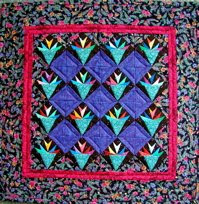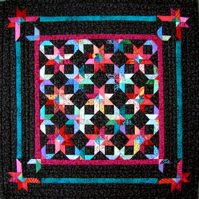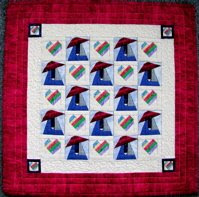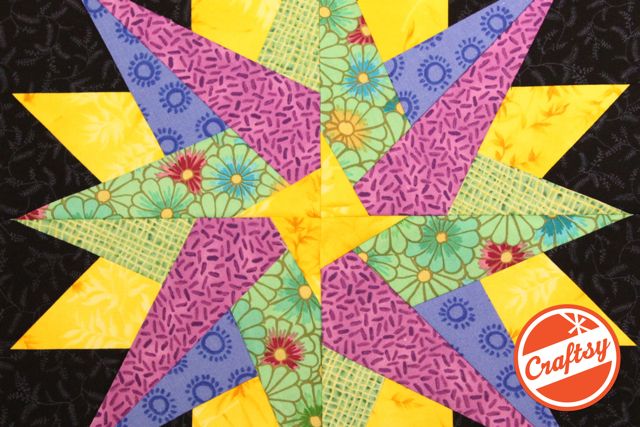
This past weekend I drove to Pennsylvania to present a lecture and workshops. I typically fly to places to teach, so this 7 1/2-hour drive gave me plenty of time to reflect and enjoy the ride. I began to think about one of the biggest misconceptions quilters have about paper piecing….that bigger is easier. In life, bigger usually is easier…we grew up with “big blocks” and “large print” in kindergarten. In traditional quilting, larger blocks typically are fewer pieces and are easier. With paper piecing, it is just the opposite…smaller really is easier. I was introduced to this notion by one of my students who took a small graphic I provided in a handout and went home to make the block. She sent me a picture and shared her excitement. It is not more difficult to sew a short line or a line that is closer together and with paper piecing, that produces a small piece. The Nosegay quilt at the left was my first miniature paper-pieced quilt and I was hooked!
After making this first quilt, I set out to design lots more miniature quilts. I could take advantage of incorporating paper-pieced borders because they would fit on a piece of paper. I could pre-cut all my fabric pieces and eliminate cutting lots of different sizes. With the Nosegay quilt, the background pieces used in the top of the block were cut the same size because they just needed to be larger than the area they need to fill. Creating a cutting list for paper piecing was actually born out of designing miniature quilts. Because the pieces don’t need to be the exact size, just bigger than the area they need to fill, the fabric pieces are huge in relationship to the patch they are covering. When I am paper piecing miniatures, it almost feels like a carefree version of paper piecing because I don’t need to be nearly as careful.

What quilter doesn’t have a bunch of scraps hanging around that are too small to create patchwork quilts? They are perfect for scrap miniature quilts! You can stack the scraps and cut a uniform size and use them in minis. That is what I did to make the scrap stars quilt on the left. I used warm colored scraps for one end of the block and cool colored scraps for the other end. When they met, they produced both warm and cool colored scrap stars. These quilts and 13 others were featured in my book,
Easy Paper-Pieced Miniatures that I wrote in the early 1990’s. Unfortunately that book is out of print, so I have begun publishing the individual patterns and making them available in the store on
my web page. Just try one mini, I guarantee you will be hooked too. When I teach introductory paper piecing classes, the students do agree that smaller really is easier!
May all your points be perfect,
Carol
This entry was posted on Tuesday, July 15th, 2008 at 4:14 pm and is filed under Miniature Quilts.
You can follow any responses to this entry through the RSS 2.0 feed.
You can leave a response, or trackback from your own site.









July 15th, 2008 at 6:02 pm
Love the blog Carol!
It is true~~mini blocks are just as easy as a 4″ block. Carol challenged her Yahoo group to make a mini & that got me hooked. I would encourage everyone to make at least on small mini quilt. A great way to use all those scraps we just can’t seem to part with!!
Glenda in Vermont
July 17th, 2008 at 11:10 pm
Hi Carol,
I totally agree with Glenda. Although, I think Miniatures are easier to make than larger blocks, and the best part is I can use all the little tiny bits of fabric from other quilts that I just can’t seem to throw away to make an entire mini quilt! I made the mini village quilt from Carol’s Miniatures book for the Yahoo group – the little trees in the corners were less than an inch for the entire block and they were very easy to make! I encourage everyone I know who does paper piecing to at least try a miniature — how do you know you can’t do it if you don’t try?
Donna in New Hampshire
July 21st, 2008 at 11:17 am
I would like to see photos of some state stars in bed size quilts.
July 21st, 2008 at 1:38 pm
There are several pictures of larger state star quilts in the gallery section of my web page http://www.caroldoak.com
All the best,
Carol